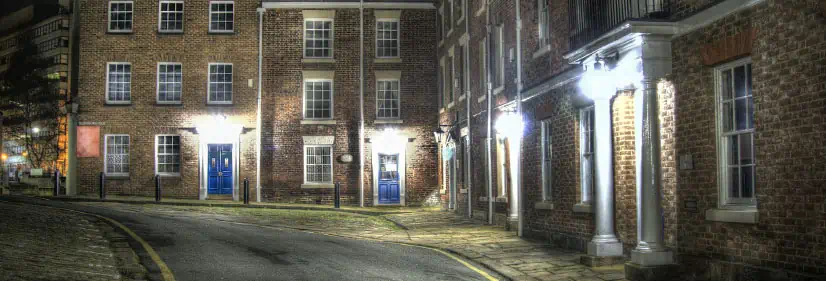
Those of you who have visited our offices in Paradise Square will surely have noticed the beautiful Georgian architecture in this hidden part of the city. Stories of ghosts, hospitals, torchlit carol services and religious and political reform abound and we are often asked about the history of our offices and the Square itself. Here is a brief guide to LFBB’s home.
From humble beginnings…
Originally a field with a thoroughfare for people travelling into Sheffield via the Cathedral from West Bar, a hospital for ‘poore persons’ was built here in 1673 – a gift from the Earl of Shrewsbury, whose family connections included the famous Bess of Hardwick. Some 60 years later, a lease was taken by Thomas Broadbent, who built the houses that run along what is now called Paradise Street (heading down the hill from Campo Lane to Queen Street). Further houses were added over the years.
The origin of the name ‘Paradise Square’ is something of a mystery. Is it just due to the proximity to places of worship, or is it more specifically an evolved version of the word ‘parvis’ which meant an open space near a Cathedral?
… To a hive of activity
You can still see the balcony from where public figures would make speeches on the front of the building next to ours. Once known as ‘Pot Square’, in around 1808 a market was established where pots and pans, crockery and, apparently, wives (yes, you read that correctly) were sold. There are also records showing that the town stocks were housed here. There has been a House of Help for girls in the Square, rat fights held at (thankfully long gone) pubs, a Freemasons Lodge, a ‘Middle Class School’, Chartist meetings, Sheffield Hebrew School and a College of Art, among a myriad of other things.
Famous Faces
Paradise Square is home to three plaques, commemorating the lives and achievements of some of its residents and visitors. Closest to us is that at number 12, where David Daniel Davis lived in the early 19th Century. His claims to fame are his role in the birth of Queen Victoria and his development of medical instruments to assist in childbirth.
Sir Francis Legatt Chantry, a famous painter and sculptor has a plaque outside number 24.
Number 3 hosts a plaque in commemoration of John Wesley, who founded the Methodist Church and preached in Paradise Square.
Spooky stories
According to legend, when the Square was still a field with a path running through it, one unfortunate mill worker was making his way to work, when he was confronted by a huge spectral dog! That’s not something any of us have ever seen (or at least we don’t admit it), but one of our solicitors claims to have heard ‘strange noises’ in one of the downstairs rooms… eventually unmasked as the reverberation of the organ in the Cathedral!
Our buildings
LFBB occupy 14 – 16 Paradise Square. If you’re looking at the office from the top of the hill, 14 is on the right and 16 on the left. Whilst the buildings are now as one, originally Blackburn & Co occupied 14 and Lewis Francis 16, but the companies merged and so did the buildings. According to Albert Jackson’s book, Paradise Square Sheffield, number 14 has in the past been home to merchants, an ex-servicemen’s federation before it finally became a solicitor’s office, and 16 has been home to a draper and printing company.
We hope you’ve enjoyed reading this brief summary of some of the goings-on in Paradise Square. We’ve got some brilliant books in our reception and many members of staff with interesting tales if you’d like to learn more.